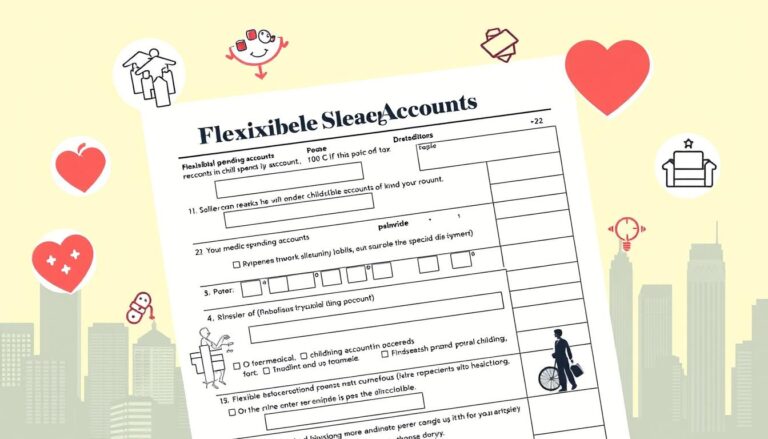Ever looked at your tax forms and wondered if your new glasses could help you save money? You’re not the only one! Figuring out if you can deduct eyeglasses can be tricky. But don’t worry, we’re here to make it clear.
Buying new glasses can be expensive. Costs can range from $100 to over $400 without insurance. But, there’s good news: your glasses might help you save money on taxes.
Before you start claiming all your glasses, slow down. The IRS has rules for tax deductions. You need to spend more than 7.5% of your income on medical expenses to qualify. It’s not easy, but it’s possible.
If you keep your receipts, you might save money on taxes. Many vision expenses, like glasses and contact lenses, could be deductible. Are you ready to learn more and save money? Let’s get started!
Key Takeaways
- Eyeglasses can cost $100 to $400+ without insurance
- Medical expenses must exceed 7.5% of AGI for deductions
- Prescription eyewear is considered a qualified medical expense
- Itemizing deductions is crucial for claiming eyeglass expenses
- Keep detailed records of all vision-related purchases
- HSAs and FSAs can be used for eyeglass expenses
- Consult a tax professional for complex medical deductions
Understanding Medical Expense Deductions
Getting to know tax deductions for vision care can be hard. It’s like trying to read an eye chart without glasses. Let’s make it easier to understand how you can use your medical expenses to your advantage.
Qualified Medical Expenses
The IRS lists many medical expenses you can deduct. These include costs for diagnosis, treatment, and prevention of diseases. Things like eye exams, glasses, and eye surgery can be deducted.
The 7.5% AGI Threshold
You can only deduct medical expenses over 7.5% of your adjusted gross income (AGI). For instance, with an AGI of $50,000, you need more than $3,750 in expenses to deduct. It’s like a game of limbo – how low can you go?
Itemizing Deductions vs. Standard Deduction
To claim these deductions, you must itemize on Schedule A of Form 1040. But think about it! The standard deduction for 2023 is $13,850 for singles and $27,700 for married couples. If your itemized deductions are less, you might want the standard deduction. It’s like choosing between a sure thing and a bigger chance – but with less work!
Remember, keeping good records of your expenses is key. It’s not just about seeing well; it’s about being smart with your taxes!
Are Eyeglasses Tax Deductible?
Good news for those seeking vision care tax benefits! Eyeglasses can indeed be tax-deductible. Let’s dive into the details of deducting eyeglasses costs and explore other eyewear tax deductions.
Prescription Eyewear as a Medical Expense
Your prescription glasses and contact lenses qualify as medical expenses. This means you can include them when calculating your medical deductions. Eye exams fall under this category too. Remember, these costs must exceed 7.5% of your adjusted gross income to be deductible.
Additional Vision-Related Deductions
Don’t stop at just glasses! You can deduct costs for:
- Eye surgeries
- Vision insurance premiums
- Travel expenses for eye care
These all count towards your total medical expenses. If you’re self-employed, you might be able to deduct health insurance premiums directly from your net profit.
Documentation Requirements
To claim these deductions, you’ll need proof. Save all receipts, bills, and prescriptions for at least three years. If you use a Health Savings Account (HSA) or Flexible Spending Account (FSA) for eyewear, those expenses aren’t tax-deductible. But hey, you’re still saving money!
By understanding these rules, you can make the most of your vision care tax benefits. Just remember, if you’re opting for standard deduction, itemizing these expenses might not be worth it. Crunch those numbers and see what works best for your wallet!
Maximizing Your Vision Care Tax Benefits
Want to make the most of your tax-deductible vision expenses? Let’s dive into some savvy strategies that’ll have you seeing green come tax season!
First up, timing is everything. Plan your eyeglasses purchases with other medical costs. This way, you’re more likely to surpass that 7.5% AGI threshold for deductions. It’s like hitting the jackpot, but with better vision!
Consider using a Health Savings Account (HSA) or Flexible Spending Account (FSA) for your vision care needs. These accounts let you pay for eyeglasses tax deduction eligible expenses with pre-tax dollars. It’s like getting a discount on your specs before you even put them on!
Self-employed? You’re in luck! You might be able to deduct your vision insurance premiums. Just make sure they exceed 7.5% of your AGI. It’s one of those rare instances where being your own boss really pays off.
- Keep detailed records of all vision-related expenses
- Compare itemized deductions to the standard deduction
- Use HSA or FSA for tax-advantaged savings
Remember, the standard deduction for 2024 is $13,850 for single filers and $27,700 for joint filers. Crunch those numbers and see if itemizing your vision care tax benefits makes sense for you. It might just be the clarity you need for a healthier bottom line!
Conclusion
Understanding eyeglasses tax deductions can be hard, like reading without glasses. But you now know how to claim vision care tax benefits. If you’re itemizing and your expenses go over 7.5% of your income, you might get to deduct your glasses and other vision costs.
The standard deduction for 2024 is $14,600 for one person and $29,200 for two people together. If your medical costs, like glasses, are more than 7.5% of your income, you can deduct them. Don’t forget to count contact lenses and eye exams too.
Keep good records of all your medical costs. This includes your glasses, contact lenses, and even eye drops. The IRS likes to see your receipts almost as much as you like your clear vision.
Claiming glasses as a tax deduction might seem small. But every dollar helps with taxes. So, clear your vision and your taxes at the same time. Just make sure to talk to a tax expert to make sure you’re doing it right.








